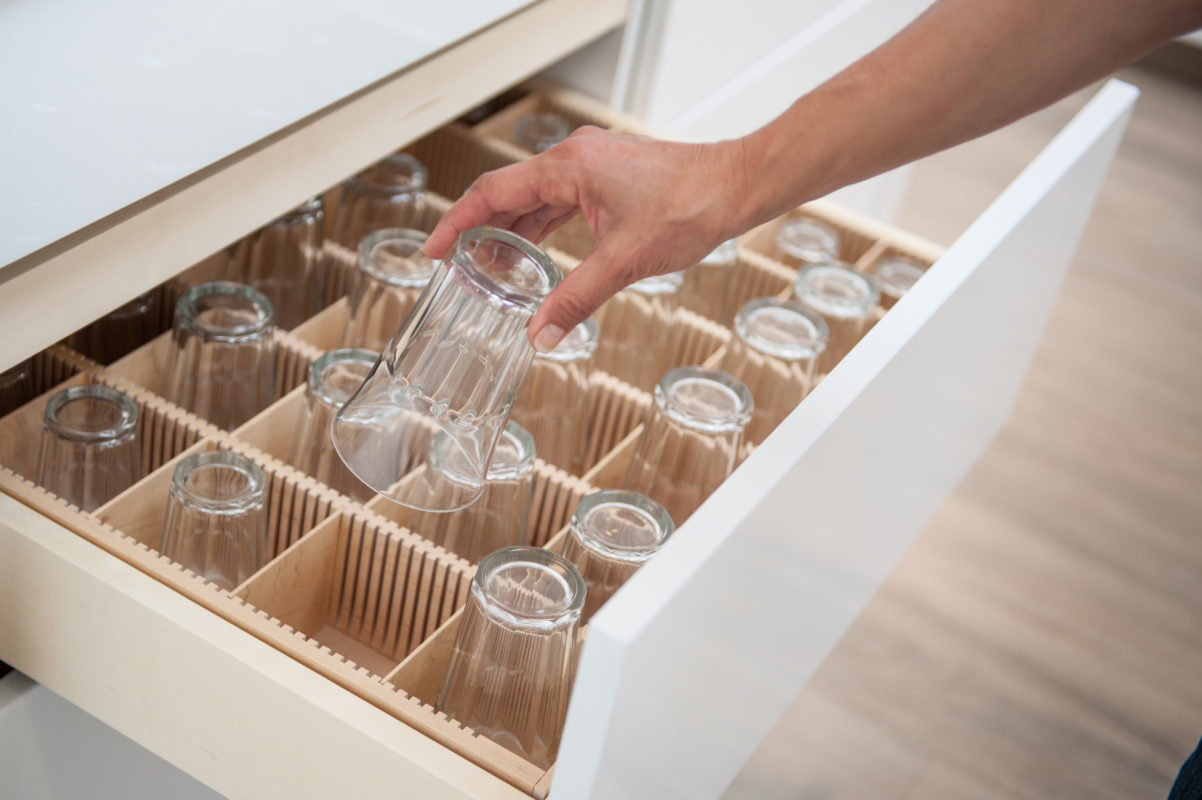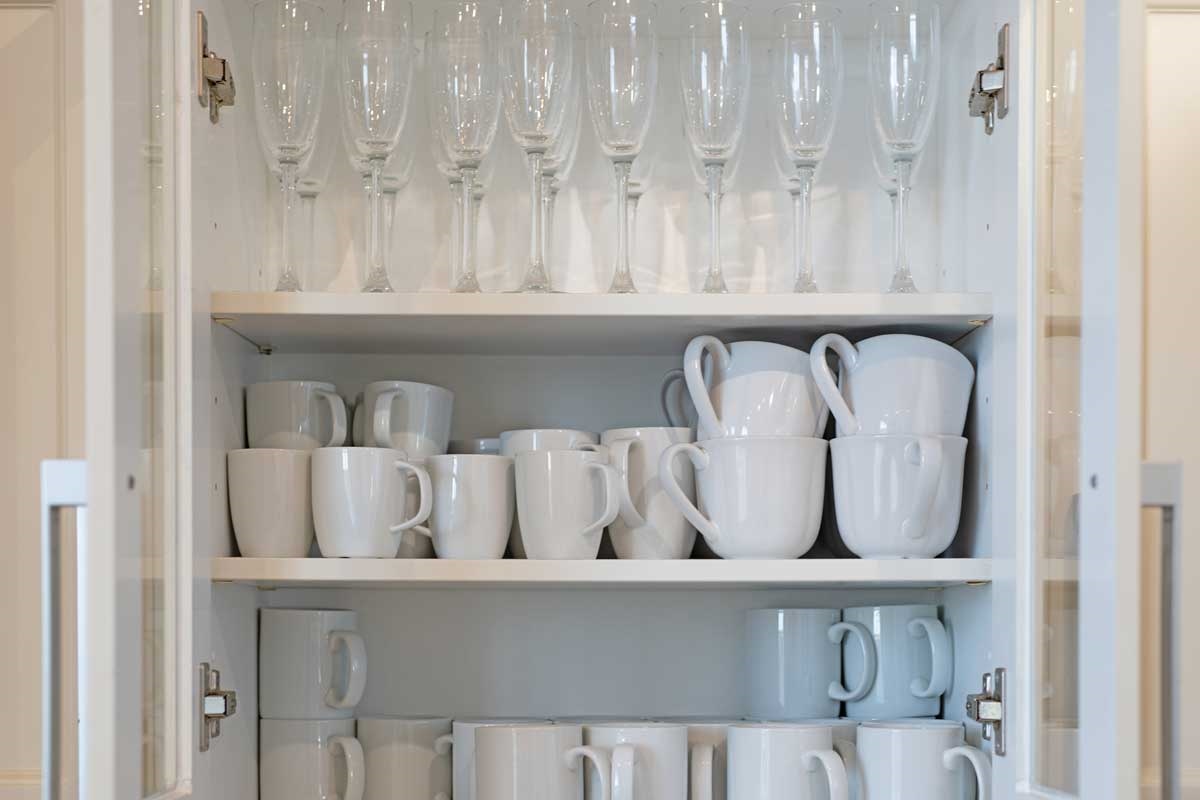Types of Glassware and Their Storage Needs

Glassware is an essential part of any kitchen, and storing it safely and efficiently is crucial. Different types of glassware require different storage approaches to prevent breakage and maintain their quality. Understanding the characteristics of various glassware types helps you create a well-organized and functional cabinet system.
Types of Glassware
Glassware can be categorized based on its material, shape, and intended use. Here are some common types found in kitchens:
- Wine Glasses: These glasses are designed to enhance the aroma and flavor of wine. They come in various shapes, such as Bordeaux, Burgundy, and Chardonnay glasses, each optimized for specific wine varieties.
- Stemware: This category includes glasses with a stem, such as martini glasses, champagne flutes, and sherry glasses. Stemware provides a comfortable grip and prevents the warmth of your hand from affecting the beverage’s temperature.
- Tumblers: Tumblers are versatile glasses without a stem, suitable for water, juice, and cocktails. They come in various sizes and materials, including glass, plastic, and stainless steel.
- Beer Glasses: These glasses are designed to enhance the flavor and aroma of beer. They come in various shapes, such as pint glasses, pilsner glasses, and wheat beer glasses.
- Shot Glasses: These small glasses are typically used for consuming small amounts of spirits. They are usually made of thick glass to withstand the impact of being slammed on a bar counter.
- Goblets: Goblets are large, stemmed glasses with a wide bowl, often used for serving water or juice. They are a traditional style of glassware.
- Coffee Mugs: These mugs are designed for holding hot beverages, such as coffee and tea. They come in various sizes, shapes, and materials, including ceramic, glass, and stainless steel.
Storage Considerations for Glassware
Storing glassware properly is essential to prevent breakage and maintain its quality. Here are some considerations:
- Fragile Nature: Glassware is delicate and prone to breakage. It’s important to handle it with care and store it in a way that minimizes the risk of damage.
- Stacking: Stacking glassware can lead to scratches and chips. Consider using dividers or trays to separate glasses and prevent them from rubbing against each other.
- Space: Ensure that there is enough space between glasses to allow for air circulation and prevent them from getting scratched or chipped.
- Placement: Avoid placing heavy items on top of delicate glassware. This can cause them to break or become damaged.
- Material: Different materials require different storage approaches. For example, crystal glassware is more delicate than regular glass and should be stored separately.
Organizing Glassware, How to hold glass in a cabinet door
Organizing your glassware can make it easier to find what you need and keep your cabinets looking tidy. Here are some tips:
- Usage Frequency: Store glasses you use most frequently in easily accessible areas, such as the front of the cabinet or on a shelf within reach.
- Aesthetics: Arrange glassware in a visually appealing way. Consider grouping glasses by type, color, or size.
- Functionality: Consider the size and shape of your cabinet when organizing glassware. You may need to use shelves, dividers, or trays to maximize space and create a functional storage system.
Cabinet Door Organization and Design: How To Hold Glass In A Cabinet Door

Maximizing cabinet door space for glassware storage is a game-changer for any kitchen. By thoughtfully organizing your cabinet doors, you can create a system that’s not only efficient but also visually appealing. Let’s explore the various solutions available and design a sample layout for your inspiration.
Shelves
Shelves are a versatile and affordable solution for cabinet door organization. They offer a straightforward way to create additional storage space.
- Advantages:
- Easy to install and adjust.
- Versatile for various glassware sizes.
- Cost-effective.
- Disadvantages:
- Can limit visibility and accessibility of glassware.
- May require careful placement to prevent items from falling.
Racks
Racks are specifically designed for holding glassware, offering dedicated slots or compartments for various shapes and sizes. They are excellent for organizing stemware, wine glasses, and delicate pieces.
- Advantages:
- Provide secure and organized storage.
- Enhance visibility and accessibility.
- Available in various materials and designs to complement kitchen decor.
- Disadvantages:
- Can be more expensive than shelves.
- May require specific measurements for proper fit.
Dividers
Dividers are a simple yet effective way to separate glassware within a shelf or drawer. They can help prevent items from clinking together and ensure organized storage.
- Advantages:
- Increase storage efficiency.
- Provide visual separation for easy identification.
- Available in various materials, including wood, metal, and plastic.
- Disadvantages:
- May not be suitable for all types of glassware.
- Can limit flexibility if you need to adjust the storage layout.
Specialized Glassware Holders
For specific glassware types, specialized holders offer dedicated storage solutions. These holders are often designed for delicate pieces like champagne flutes or wine glasses.
- Advantages:
- Provide secure and safe storage.
- Enhance the visual appeal of the cabinet door.
- Available in various styles and materials to complement kitchen decor.
- Disadvantages:
- Can be more expensive than general storage solutions.
- May require specific measurements for proper fit.
Sample Cabinet Door Layout
Here’s a sample layout for a cabinet door, incorporating multiple storage solutions:
| Section | Storage Solution | Dimensions | Notes |
|---|---|---|---|
| Top | Shelf with dividers | 12″ x 18″ | Ideal for storing everyday glasses and mugs. |
| Middle | Wine glass rack | 12″ x 12″ | Provides dedicated storage for wine glasses. |
| Bottom | Specialized champagne flute holder | 6″ x 12″ | Ensures safe storage for delicate champagne flutes. |
This sample layout demonstrates how to combine various storage solutions to create an efficient and visually appealing cabinet door organization system. Remember to consider the size and shape of your glassware when choosing storage solutions and designing your layout.
Safe Handling and Storage Techniques

Storing glassware in a cabinet door requires careful handling and storage techniques to prevent breakage and ensure their longevity. Proper handling and storage techniques can minimize the risk of damage and maintain the beauty and functionality of your glassware.
Proper Handling Techniques
Handling glassware with care is crucial to prevent breakage. Here are some tips for safe handling:
- Always wash your hands before handling glassware to avoid transferring oils or dirt that can leave smudges.
- When picking up glassware, use a firm grip with your entire hand, not just your fingertips. Avoid holding glassware by the rim, as this can weaken the glass and lead to breakage.
- If you’re carrying multiple pieces of glassware, space them out to prevent them from clinking together and potentially breaking.
- Avoid placing glassware on uneven surfaces or near the edge of counters, as this can lead to accidental falls.
Securing Glassware in the Cabinet Door
Securing glassware within the cabinet door is essential for stability and to prevent accidental spills. Here are some methods for securing glassware:
- Use a cabinet door organizer with compartments designed to hold different sizes of glassware. These organizers help to keep glassware upright and prevent them from shifting during opening and closing the door.
- Consider using dividers or separators within the cabinet door to create individual spaces for each piece of glassware. This helps to minimize movement and prevent accidental contact between pieces.
- For taller glassware, such as wine glasses or champagne flutes, use a dedicated rack or holder that attaches to the inside of the cabinet door. This ensures they are stored securely and upright.
- If using shelves within the cabinet door, make sure they are sturdy and able to support the weight of the glassware. Avoid overloading shelves to prevent them from sagging or collapsing.
Padding and Cushioning Materials
Using appropriate padding and cushioning materials can help to protect delicate glassware during storage and retrieval. Here are some materials that can be used:
- Soft cloths or towels can be placed between glassware to prevent them from clinking together and scratching. They also provide a layer of protection against bumps and knocks.
- Foam padding, such as that used for packing electronics, can be cut to size and used to line the bottom of the cabinet door or individual compartments. This helps to absorb shock and prevent glassware from breaking if they fall.
- Bubble wrap can be used to wrap individual pieces of glassware, especially fragile items like stemware or crystal. This provides a cushioning layer that can help to protect against damage during transport or storage.
Loading and Unloading Glassware
Proper loading and unloading of glassware from a cabinet door is essential for safety and to prevent breakage. Here is a step-by-step guide:
- Open the cabinet door slowly and carefully, avoiding sudden movements that could jostle the glassware.
- Use a firm grip when removing glassware from the cabinet door, ensuring that your fingers are not near the edge of the glass.
- If using shelves, carefully slide the glassware out of the shelf, avoiding any sudden movements that could cause it to fall.
- When loading glassware back into the cabinet door, gently place it in its designated space, ensuring it is secure and upright.
- Close the cabinet door slowly and carefully, ensuring that all glassware is securely in place before fully closing the door.
How to hold glass in a cabinet door – When holding glass in a cabinet door, it’s crucial to be gentle and avoid applying too much pressure. If you’re looking for a cabinet that combines style and functionality, consider checking out canadian tire cabinets with glass doors. They offer a sleek and modern aesthetic, while still providing ample storage space.
Remember, even with the most sturdy cabinets, handling glass with care is essential to prevent breakage and ensure your kitchen remains a safe and functional space.
When installing glass in your kitchen cabinet doors, remember to handle it with care. The type of glass you choose can impact both its appearance and its functionality. For example, frosted glass can provide privacy while clear glass offers a modern and open look.
Consider the types of glass for kitchen cabinet doors available and choose the one that best suits your style and needs. Once you’ve selected your glass, ensure you have the right tools and techniques for safe and secure installation.
